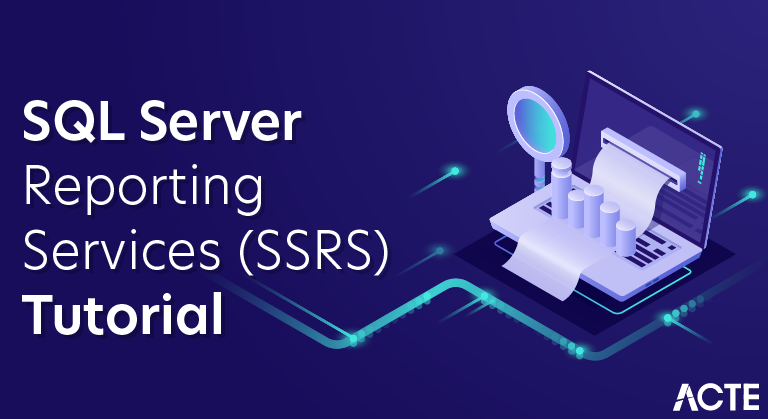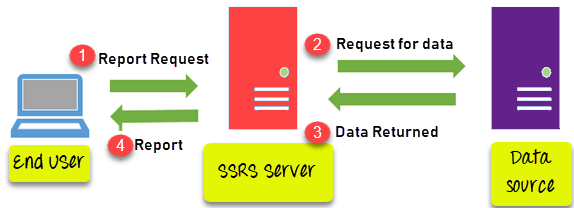
SQL Server Reporting Services (SSRS) is a robust reporting tool from Microsoft’s SQL Server suite, empowering organizations to create, manage, and distribute interactive and printed reports effectively. SSRS supports diverse data sources, including relational databases and data warehouses, ensuring versatility in meeting various business requirements. Users can design visually appealing reports through an intuitive interface and customize them with formatting options, charts, and interactive features. The tool facilitates automated scheduling and delivery of reports, enhancing accessibility to critical insights for informed decision-making and performance monitoring across enterprises.
What is SSRS?
SQL Server Reporting Services (SSRS) is a comprehensive reporting platform developed by Microsoft that is designed to facilitate the creation, management, and distribution of a wide range of reports within organizations. It functions as a centralized tool for producing several kinds of reports, such as tabular, graphical, interactive, and free-form reports. SSRS supports data retrieval from multiple sources, including relational databases like SQL Server, multidimensional databases, and XML data sources, offering flexibility in data integration and reporting.

One of SSRS’s key strengths lies in its user-friendly report design interface, which allows developers and business users to create visually appealing reports with ease. The platform provides a rich set of features for report customization, including formatting options, charts, graphs, and interactive elements, enabling users to tailor reports to specific business requirements.
Moreover, SSRS facilitates efficient report management through capabilities such as report scheduling, automated report delivery via email or file share, and version control. It integrates seamlessly with other Microsoft technologies, enhancing its usability and compatibility with existing IT infrastructures.
Overall, SSRS plays a pivotal role in supporting data-driven decision-making processes by delivering timely, accurate, and actionable insights across departments and functions within an organization. Its versatility, integration capabilities, and robust feature set make it a preferred choice for businesses seeking powerful reporting and analytics solutions.
What are the reasons for utilizing SSRS?
There are several compelling reasons for organizations to utilize SSRS (SQL Server Reporting Services):
- Comprehensive Reporting Capabilities: SSRS offers robust tools for creating a wide range of reports, including interactive, tabular, graphical, and free-form reports. It supports various data sources like SQL databases, XML, and multidimensional models, making it versatile for different reporting needs.
- Integration with Microsoft Ecosystem: As part of the Microsoft SQL Server suite, SSRS seamlessly integrates with other Microsoft technologies such as SQL Server, Power BI, and SharePoint. This integration facilitates data sharing and collaboration and enhances overall data management within the organization.
- Ease of Use: SSRS provides an intuitive, user-friendly interface for designing and customizing reports. Business users and developers can easily create visually appealing reports with charts, graphs, and drill-down capabilities without extensive programming knowledge.
- Scalability and Performance: SSRS is designed to handle large datasets and scale with the organization’s growth. It includes features for optimizing report performance, such as caching, report snapshots, and efficient data processing.
- Scheduled and Automated Reporting: SSRS enables users to schedule report generation and distribution based on specific time intervals or events. Reports can be automatically delivered via email or saved to a file share, ensuring timely access to critical business insights.
- Security and Access Control: SSRS offers robust security features to protect sensitive data and ensure regulatory compliance. Administrators can define role-based access control, encrypt data during transmission, and audit report usage to maintain data integrity and confidentiality.
- Cost-Effective Solution: For organizations already using Microsoft SQL Server, SSRS is a cost-effective option as it is included with the SQL Server licensing. It eliminates the need for additional third-party reporting tools, reducing overall IT infrastructure costs.
- Support for Decision-Making: By providing accurate and actionable insights through well-designed reports, SSRS supports informed decision-making across departments. It empowers stakeholders to analyze trends, monitor performance metrics, and identify areas for improvement effectively.
Overall, SSRS is a powerful tool that enhances organizational efficiency, improves data-driven decision-making, and facilitates seamless reporting and analytics processes within the Microsoft ecosystem.
Tutorial Scope for SSRS
Introduction to SSRS
- Overview of SSRS: Introduction to SQL Server Reporting Services, its components, and how it fits into the SQL Server suite.
- Importance of Reporting: Understanding the need for reporting in business intelligence and data analysis.
SSRS Architecture and Components
- Report Server: Detailed look at the Report Server, including its architecture and functionality.
- Report Manager: An introduction to the Report Manager, detailing its interface and the process of managing reports.
- Report Builder and SSDT: Introduction to the tools used for report design – Report Builder and SQL Server Data Tools (SSDT).
Setting Up SSRS
- Installation and Configuration: Step-by-step guide on installing and configuring SSRS.
- Database Setup: Creating and configuring the ReportServer and ReportServerTempDB databases.
- Configuring Report Server: Configuring URLs, email settings, and execution accounts.
Creating Basic Reports
- Data Sources and Datasets: Connecting to data sources and defining datasets.
- Report Design Fundamentals: Crafting basic reports using tables, matrices, and lists.
- Formatting Reports: Applying styles, formatting data, and adding images and charts.
Advanced Report Design
- Expressions and Functions: To modify data and personalize reports, use expressions and built-in functions.
- Parameters and Filters: Adding parameters and filters to reports for dynamic data retrieval.
- Subreports and Drillthroughs: Creating subreports and drillthrough reports for detailed data analysis.
Deploying and Managing Reports
- Deploying Reports: Publishing reports to the Report Server.
- Managing Report Content: Organizing reports, creating folders, and managing report properties.
- Security and Permissions: Setting up role-based security and managing user access to reports.
Report Subscriptions and Delivery
- Standard Subscriptions: Creating and managing standard report subscriptions.
- Data-Driven Subscriptions: Setting up data-driven subscriptions for dynamic report delivery.
- Delivery Formats: Exploring different report delivery formats (PDF, Excel, Word, etc.).

Interactive and Ad-Hoc Reporting
- Interactive Features: Incorporating elements such as sorting, drill-down capabilities, and document maps.
- Ad-Hoc Reporting with Report Builder: Empower end-users to create their reports using Report Builder.
- Linking reports for several data views can be accomplished by using parameters.
Performance and Optimization
- Performance Tuning: Techniques for optimizing report performance.
- Caching and Snapshots: Using caching and report snapshots to improve performance.
- Monitoring and Logging: Tools and practices for monitoring report server performance and troubleshooting issues.
Integration with Other Tools
- Integration with SharePoint: Using SSRS with SharePoint for collaborative reporting.
- Integrating SSRS and Power BI to enhance data visualization capabilities is known as Power BI Integration.
- Embedding Reports: Embedding SSRS reports into web applications and portals.
Best Practices and Security
- Best Practices: Guidelines for designing efficient and maintainable reports.
- Security Measures: Implementing security best practices to protect report data.
- Compliance: Ensuring SSRS implementations comply with data privacy and security regulations.
Real-World Applications
- Case Studies: Examples of SSRS implementations in various industries.
- Capstone Project: Building a comprehensive SSRS project that encompasses all learned concepts.
SSRS Prerequisites:
Specific prerequisites are recommended to learn and utilize SQL Server Reporting Services (SSRS) effectively. These prerequisites ensure that learners have the foundational knowledge and technical skills needed to understand and implement SSRS functionalities. Here is a detailed list of the prerequisites for SSRS:
1. Basic Knowledge of SQL Server:
- Knowledge of SQL Server: A working knowledge of the various parts and features of SQL Server.
- SQL Query Language: Proficiency in writing and understanding SQL queries, including SELECT, INSERT, UPDATE, and DELETE statements.
- Database Concepts: Understanding of database concepts such as tables, relationships, indexes, and primary/foreign keys.
2. Familiarity with Business Intelligence (BI) Concepts:
Understanding the fundamental ideas and principles of data warehousing.
ETL Processes: Knowledge of Extract, Transform, Load (ETL) processes and tools, particularly those within the SQL Server suite (e.g., SQL Server Integration Services).
3. Basic Understanding of Reporting and Analytics:
- Report Design: General knowledge of report design principles and best practices.
- Data Analysis: Proficiency in fundamental data analysis and visualization methods.
4. Knowledge of Microsoft Windows and Networking:
- Windows Operating System: Proficiency in using the Windows operating system and navigating its features.
- Networking Basics: Basic understanding of networking concepts and how they relate to server-client environments.
5. Familiarity with Visual Studio:
- Visual Studio IDE: Basic knowledge of using Visual Studio Integrated Development Environment (IDE) can be beneficial, especially for developing and deploying SSRS reports using SQL Server Data Tools (SSDT).
6. Understanding of Web Technologies:
- HTML/CSS: Basic knowledge of HTML and CSS can be helpful for customizing report layouts and styles.
- Knowledge of JavaScript can be beneficial for enhancing reports with interactive elements.
7. Administrative Skills:
- Server Management: Basic knowledge of server management, including managing server settings and configurations.
- Security Practices: Understanding of security practices for managing user permissions and securing report data.
8. Software and Hardware Requirements:
- SQL Server Installation: Ensure that SQL Server (with the SSRS feature) is installed and properly configured on your machine or server.
- Development Tools: Install necessary development tools, such as SQL Server Data Tools (SSDT) or Report Builder.
- Adequate Hardware: Ensure that your system meets the hardware requirements for running SQL Server and SSRS smoothly.
Comprehensive Guide to SSRS
- STEP 1: Prerequisites Check: Verify system requirements such as hardware specifications, operating system compatibility, and necessary software dependencies.
- STEP 2: Download SSRS Installer: Obtain the SSRS installer from Microsoft’s official website or your organization’s licensed distribution channels.
- STEP 3: Installation Process: Run the installer and follow the wizard to install SSRS on your designated server or machine.
- STEP 4: Configuration Steps: Configure SSRS settings during installation, including setting up database options, report server instances, and service accounts.
- STEP 5: Post-Installation Tasks: Perform post-installation tasks such as configuring web portal settings, setting up security permissions, and integrating with existing SQL Server instances if applicable.
- STEP 6: Testing and Validation: Verify the installation by accessing the SSRS web portal, running sample reports, and ensuring connectivity to data sources.
- STEP 7: Troubleshooting Tips: Be prepared with troubleshooting steps for common installation issues or errors encountered during the process.
- STEP 8: Documentation and Resources: Keep documentation handy for reference, including official Microsoft guides, community forums, and technical support resources for additional assistance.
By following these points, users can successfully install SSRS and leverage its robust reporting capabilities within their organization.
Configuring SSRS: Essential Steps and Best Practices
Configuring SSRS involves several essential steps and best practices to ensure optimal performance and usability:
1. Installation and Setup:
- SSRS can be installed independently or through the SQL Server Installation Center.
- Configure the SSRS instance to integrate with SQL Server Database Engine.
2. Setting up Data Sources:
- Define data sources for reports, ensuring they connect to the appropriate databases.
- Use shared data sources to centralize connection strings for consistency.
3. Security Configuration:
- Set up role-based security to control which files and reports users can access.
- Utilize Windows Authentication or custom security models based on organizational requirements.
4. Report Server Configuration:
- Customize web portal settings such as branding, navigation, and permissions.
- Configure email settings for report delivery and subscription notifications.
5. Optimizing Report Performance:
- Optimize report queries and use stored procedures for data retrieval.
- Implement caching strategies to improve report rendering speed.
6. Backup and Recovery Planning:
- Make regular backups of the encryption keys and SSRS databases.
- Document disaster recovery procedures to restore SSRS in case of system failures.
7. Monitoring and Maintenance:
- Monitor report server usage, performance metrics, and errors using SSRS management tools.
- Schedule regular maintenance tasks, including cleanup of unused reports and subscriptions.
8. Scaling and High Availability:
Implement load balancing for scalability and distribute report processing across multiple servers. Configure SSRS in a high-availability mode to minimize downtime and ensure continuous availability. By following these steps and best practices, organizations can effectively configure SSRS to meet their reporting needs while ensuring the security, performance, and reliability of their reporting infrastructure.
Establishing Basic Monitoring for SSRS
It is crucial to monitor SQL Server Reporting Services (SSRS) to guarantee its performance, reliability, and security. Here is a guide to setting up essential monitoring for SSRS:
1. SSRS Performance Counters
Windows Performance Monitor: Use Windows Performance Monitor (PerfMon) to track SSRS-specific performance counters. Key counters include:
- ReportServer: Active Sessions
- ReportServer: Report Requests
- ReportServer: Cache Hits
- ReportServer: Processing Time
- ReportServer: Execution Time
These counters provide insights into the number of active sessions, the volume of report requests, cache efficiency, and the time taken for report processing and execution.
2. SQL Server Profiler
- Monitoring Queries: Use SQL Server Profiler to capture and analyze the queries generated by SSRS. This helps detect lengthy queries and pinpoint possible performance bottlenecks.
- Creating Trace Templates: Set up trace templates to monitor specific events such as Stored Procedure executions, T-SQL queries, and errors.
3. Execution Log Reports
- Built-in Reports: SSRS comes with built-in reports for analyzing report execution logs. Access these reports from the ReportServer database to gain insights into report performance, frequency of execution, and user activity.
- Custom Execution Log Reports: Create custom reports to analyze execution logs in detail, focusing on metrics like average processing time, average rendering time, and execution frequency.
4. System Health Monitoring
- Windows Event Viewer: Monitor SSRS-related events and errors in the Windows Event Viewer. Look for events under the Application and System logs, and specifically for sources like ReportServerService and ReportServerWebApp.
- SQL Server Agent Jobs: Set up SQL Server Agent jobs to automate routine maintenance tasks such as database backups, index maintenance, and log file cleanup.
5. SSRS Logs
- Report Server Logs: Regularly check the Report Server logs (ReportServerService_<timestamp>.log) for errors and warnings. These logs are located in the SSRS log directory.
- Report Execution Logs: Analyze the ExecutionLog3 view in the ReportServer database to understand report execution patterns and troubleshoot issues.
6. Monitoring Tools Integration
- Third-Party Monitoring Tools: Integrate SSRS with third-party monitoring tools like SentryOne, SolarWinds, or Redgate SQL Monitor for more comprehensive monitoring capabilities.
- SSRS Performance Dashboard: Consider setting up a custom SSRS performance dashboard to visualize key metrics and monitor the health of your SSRS environment in real time.
7. Alerting and Notifications
- SQL Server Alerts: Configure SQL Server alerts to notify administrators of critical issues, such as high CPU usage, low disk space, or SSRS service failures.
- Email Notifications: Set up email notifications for important events and thresholds. Use SQL Server Database Mail to send alerts directly to administrators.
8. Regular Maintenance
- Database Maintenance Plans: To maintain the functionality and health of the ReportServer and ReportServerTempDB databases, regularly implement database maintenance plans. Tasks should include indexing, updating statistics, and conducting database integrity checks.
- Log File Management: Regularly archive and clean up SSRS log files to prevent disk space issues and maintain performance. Implementing these monitoring techniques can ensure that your SSRS environment remains stable, performs efficiently, and provides reliable reporting services to your organization.
Conclusion:
In summary, SQL Server Reporting Services (SSRS) represents a powerful reporting tool in Microsoft’s suite, designed to empower organizations with comprehensive capabilities for generating and distributing reports. SSRS stands out for its intuitive interface, which simplifies the creation of diverse reports that include interactive, tabular, and graphical formats. This tool integrates seamlessly with various data sources, enabling users to consolidate and analyze data from relational databases, data warehouses, and other sources effectively. Whether deployed on-premises or in the cloud, SSRS supports flexible deployment options, ensuring scalability and accessibility across different organizational environments.
Moreover, SSRS plays a pivotal role in enhancing decision-making processes by providing timely insights through scheduled report delivery and customizable dashboards. Its robust security features enable organizations to control access and ensure data confidentiality, meeting regulatory compliance requirements. By leveraging SSRS, businesses can streamline reporting workflows, improve operational efficiencies, and foster data-driven strategies that drive business growth. As organizations increasingly rely on data-driven insights, SSRS continues to be a trusted solution for delivering accurate, actionable information that supports informed decision-making at all organizational levels.





